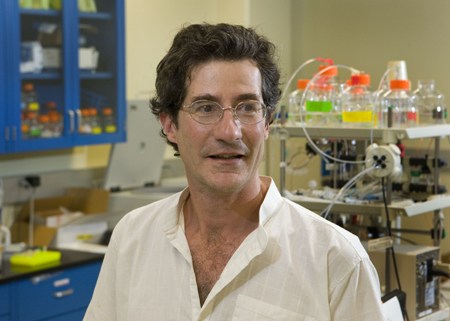Giovanni Zocchi, a physics professor at University of California, Los Angeles (UCLA) and Yong Wang, a physics postdoctoral fellow from the University of Illinois in Urbana–Champaign and a former physics graduate student at UCLA, have demonstrated a nanomechanical method to measure protein molecules at a resolution 100 folds higher than earlier mechanical measurements.
 Giovanni Zocchi in his UCLA physics laboratory (Credit: Reed Hutchinson/UCLA)
Giovanni Zocchi in his UCLA physics laboratory (Credit: Reed Hutchinson/UCLA)
From the nanomechanical measurements of an individual protein molecule called guanylate kinase, an enzyme that produces GDP by modifying a phosphate group from ATP to GMP, the researchers discovered that the molecule behaves like a liquid at times, and like a solid at others. According to Zocchi, protein molecules behave as either a complex solid or a complex fluid, which is visco-elastic in nature and is capable of storing and releasing mechanical energy.
Zocchi stated that it was not possible to observe the visco-elastic behavior of isolated proteins clearly using earlier mechanical measurement methods, as they have a tendency to destroy the proteins. However, the novel nanotechnology technique enabled the researchers to apply stresses on the isolated protein molecule in order to probe its mechanics without affecting it.
When they applied stresses, what they had found was a transformation into a visco-elastic regime by the protein due to its mechanical response. Zocchi explained that below the transformation, the protein molecule behaved like a spring by responding elastically, while the molecule flowed as a viscous liquid above the transition. However, the transformation of the molecule can be reversed by removing the stress, he said. Functional conformational modifications of enzymes such as the alterations in the molecule shape must usually occur throughout this transition, he added.